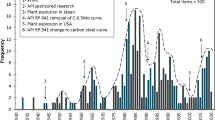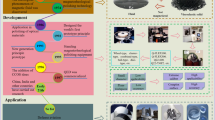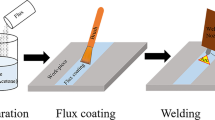Abstract
In mechanized or automatic GMAW welding, when necessary, weaving is usually performed by mechanical devices. On the other hand, magnetic fields are commonly used for the same purpose in mechanized GTA welding. Experiments were carried out using GMAW with short-circuit, and pulsed metal transfer in which controlled magnetic oscillation was applied. A clear influence of the imposed magnetic field on process stability was observed, and its effect was associated to the shielding gas mixture composition. Therefore, the present work evaluates the effect of magnetic arc oscillation in the pulsed GMAW using two argon-based shielding mixtures, one containing 18%CO2 (a commonly used composition for short-circuit metal transfer operation) and the other with 4%CO2. Welding trial with different pulse conditions and magnetic field strength for arc deflection were performed. The results indicated a degradation of process stability by the magnetic field with arc extinctions occurring during the base period of the pulsed current and preferably when the arc deflection was close to its maximum. High-speed videos showed that the arc deflection was more intense during the base period leading to excessive arc elongation, high welding voltage values and, eventually, to extinction of the arc. Results also indicated that higher CO2 content in the shielding gas favors process instability in the presence of the magnetic field. This was associated with a higher sensitivity of the welding voltage to arc length variations caused by the arc deflection due to the applied magnetic field.













Similar content being viewed by others
Notes
ASTM—American Society for Testing and Materials.
AWS—American Welding Society.
References
Mustafin FM et al (2002) Pipe welding. Nedra, Moscow, p 65
Akulov AI et al (1977) Electrical fusion welding technology. Machinostroenie, Moscow, p 21
Poluxin PI et al (1977) Materials technology and welding. Moscow, p 312
Fonseca CS, Pinheiro IP, Silva SN (2016) Influence of thermal intake on austenite morphology and on the amount of phases in SAF 2205 duplex stainless steel welded plates. Revista Matéria 21(1):227–234
Castro RM (2011) Effect of thermal intake on welding of repairs embedded in pipelines. REDEMAT, Materials Engineering, Federal University of Ouro Preto—UFOP
Lins AS Jr (2013) Evaluation of the mechanical properties of HY-80 steel welded joints. Federal Center for Technological Education—CEFET
SAS (2019) P. Polysoude, 2 rue Paul Beaupère, 44300 NANTES, France. http://www.polysoude.com/. Accessed 15 Feb 2019
Welding Technology Centre (WTC) (2019) S. H. W. T. C. SERIMAX HOLDINGS, Roissy en France 95926, 346 rue de la belle étoile—CS 90023. http://www.serimax.com/en/about-us-premium-welding-solutions/. Accessed 15 Feb 2019
Lincoln Electric Company (2019) DirectArc Magnetic Arc Control - Arc Products. https://www.arcproducts.com/product/directarc-magnetic-arc-control/. Accessed 10 Aug 2019
Han Gil Industry Co (2019) Korea, Magnetic Arc Weave. http://www.autowelding.com/eproduct29.htm. Accessed 10 Aug 2019
CRC-Evans NS Pipeline International (2020) Houston, Texas 77066, USA. http://www.crc-evans.com. Accessed 29 Sept 2020
Reis RP, Souza D, Scotti A (2011) Models to describe plasma jet, arc trajectory and arc blow formation in arc welding. Phys Weld 55(3–4)
Clain FM, Teixeira PRDF, Araújo DB (2017) Two heat source models to simulate welding processes with magnetic deflection. Federal University of Rio Grande do Sul, UFRG, School of Engineering, Federal University of Uberlândia, UFU, Uberlândia
Juliani L, Bracarense AQ, Modenesi PJ (2020) System for magnetic oscillation of the arc capable of generating figures of Lissajous, Federal University of Minas Gerais—UFMG, Belo Horizonte
Modenesi PJ, Bracarense AQ (2017) Introduction to electric arc physics and its application in metal welding. Federal University of Minas Gerais, UFMG, Belo Horizonte, 2017. Chapter 11—77–105, Chapter 12—pp 113–126
Scotti A, Ponomarev V (2008) Welding MIG/MAG, Artliber Publishing House. 2008 edition, Chapter 2—pp 121–156, pp 204–208, 2014 Edition, Chapter 1, section 1.8—Gases de proteção, pp 96–108
Tatagiba LCS, Gonçalves RB, Paranhos R (2012) Trend in the development of protective gases used in MIG/MAG welding. Weld Inspect 17(3):218–228
Liskèvych O (2010) Study of the influence of CO2 content on metal transfer regularity and MIG/MAG process stability. Master's thesis, Federal University of Uberlândia, UFU, Minas Gerais
Yong Z, Xiaojian S et al (2018) Effect of shielding gas on the metal transfer and weld morphology in pulsed current MAG welding of carbon steel. J Mater Process Technol. https://doi.org/10.1016/j.jmatprotec.2018.07.003
Modenesi PJ, Matilde S et al (2012) A computer program to simulate some operational aspects of MIG/MAG welding. Weld Inspect 17(1):5
Kang YH, Na SJ (2002) Study on the modeling of magnetic arc deflection and dynamic analysis. Weld J 5:66
Larquer TR, Souza DM, Reis RP (2016) TIG welding with synchronized magnetic oscillation. Weld Inspect 3:363–378
Rokhlin SI, Guu AC (1993) A study of arc force, pool depression, and weld penetration during gas tungsten arc welding. Weld J 66:381s–390s
Wang L, Chen J et al (2020) Numerical analysis of arc and droplet behaviors in gas metal arc welding with external compound magnetic field. J Mater Process Technol 282:116638
Acknowledgements
Special thanks to Prof. Alberto Gontijo—Control and Automation of the COLTEC Technical College and engineer André Martins Vaz—Control and Automation Engineer, without whom the magnetic oscillator system would not have been finalized. Thanks also to Prof. Matheus Pereira Porto—THERMOMETRY, all from the Federal University of Minas Gerais—UFMG.
Author information
Authors and Affiliations
Corresponding author
Additional information
Technical Editor: Monica Carvalho.
Publisher's Note
Springer Nature remains neutral with regard to jurisdictional claims in published maps and institutional affiliations.
Rights and permissions
About this article
Cite this article
Juliani, L., Bracarense, A.Q. & Modenesi, P.J. Study of the behavior of the electric arc in pulsed GMAW influenced by magnetic oscillation using shielding gas mixtures with different CO2 content. J Braz. Soc. Mech. Sci. Eng. 43, 325 (2021). https://doi.org/10.1007/s40430-021-03033-1
Received:
Accepted:
Published:
DOI: https://doi.org/10.1007/s40430-021-03033-1




